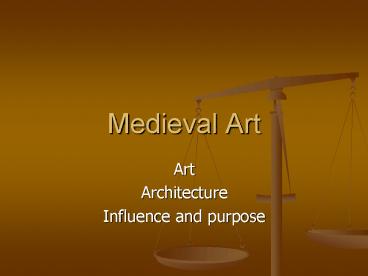Medieval Art - PowerPoint PPT Presentation
1 / 29
Title: Medieval Art
1
Medieval Art
- Art
- Architecture
- Influence and purpose
2
Early Churches 70 ADKing Herods Temple (not
Christian)
3
Early Churches
These are actually the Dome of the Rock and the
Al-Aqsa Mosque in Jerusalem, two of the holiest
places in Islam.
4
Early Churches 230 ADQ What is the make up of
FRESCO medium? A Mixing dry pigment with
plaster to paint onto a wall.
5
Early Christian House 230 AD
6
Roman basilica 324 AD
7
Early Roman Church
- Early Christian Architecture basilical church
developed from Roman secular basilica
centralized type from Roman tombs. Basilical plan
modified for liturgical requirements
congregation and clergy segregated in nave and
aisles vs. transept and apse (the place of
magistrate). Different variants in East and West.
8
In the Early Roman Church
- In Rome, classical marble wall membering and
vocabulary, and emphasis on massive wall,
gradually replaced by broad, flat surfaces,
evenly lighted plain brick exteriors mosaic
bands of interiors. Long planes with little
articulation, either horizontal or vertical.
9
Early Christian basilica
10
Central Plan
- Eastern Europe
- Designed after Roman Temples like the Pantheon.
- Eventually these were transformed into Mosques
for Islamic worshipers
11
Central Plan Example Interior
12
Basilica Plan
- Design eventually symbolizes the cross.
- Roman influence
- Western Europe
- Q How does the architecture reflect the
Medieval culture? - A The entire floor plan represents the cross
that Jesus died on for the remission of sins.
13
Early Christian basilica
- Basilicas were also adapted to the function as
audience halls as part of palace complexes. A
good example of this is presented by the Palace
Basilica of Constantine in the northern German
town of Trier
14
Early Christian basilica
- Constantine and his Church planners also needed
an architecture that had meaning in the Roman
world. Totally new architectural forms would not
be as effective as architectural forms that
carried meaning. This led to use of category of
Roman building known as the Basilica. Roman
basilicas served places for public gatherings
law courts, financial centers, army drill halls,
reception rooms in imperial palaces. Roman cities
would regularly have a Basilica as a central
public building. It was, like our City Hall, a
center of public power.
15
Notre Dame From the rear
16
Notre Dame
- Gargoyle (From French word gargouille which
means throat or pipe. - Much more organic style compared to Roman
architecture. - Q What type of lines were used to design these
gargouilles? - A Organic lines were used to design theses
gargouilles.
17
Notre Dame
- Flying buttresses
- Used to keep building standing
- And as a gutter system as well.
- With the gargoyle at the end of each.
18
The Flying Buttresses Gothic Churches
- Acting as a brace as well as a gutter system.
19
The Interior of Notre Dame
20
The Interior of Notre Dame
21
Older and Newer
22
The Interior of Notre Dame
23
Notre Dame
- Notice the images on the outside.
- Relief Sculptures surround all the doors.
- Narrative in Purpose
24
Notre Dame DetailThe Last Judgement
25
Notre Dame DetailThe Last Judgement
- Q What is this particular sculpting medium
called when its not completely 3/Dimensional? - A This type of sculpture is call RELIEF
SCULPTURE, where you only sculpt a raised image
on a mostly flat panel.
26
Notre Dames Facade
27
Compare the two
Which design has the most Geometric Lines and
Forms in it's design?
The Greek design has the most simple and the most
Geometric lines in its' design, when compared to
Notre Dame.
28
By Comparison
- Both create pattern, but Early Roman style
appears more GEOMETRIC. - Gothic seemed to be more focused on fine DETAILS
and sculptures as part of their design and more
ORGANIC.
29
Medieval/Gothic Style
- Images (mosaics) on the ceiling and the walls
- Narrative in purpose
- Reflecting the religious beliefs of the culture.































![read [pdf] medieval warfare: a history PowerPoint PPT Presentation](https://s3.amazonaws.com/images.powershow.com/10141141.th0.jpg?_=20240927044)